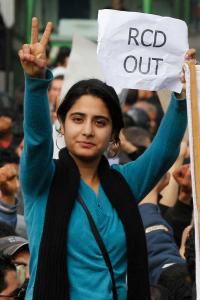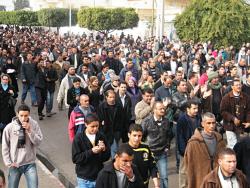Finally,
after a long wait, prime minister Gannouchi announced changes in the
government of national unity which was formed in Tunisia after the
overthrow of Ben Ali. The masses of workers and youth, for two weeks,
have been demanding the overthrow of this government, which they
consider as a continuation of the old regime. They have staged massive
regional strikes and demonstrations and a sit-in outside the
government’s office. This new government of Gannouchi must also be
rejected and the people take power into their own hands.
 The slogan still remains relevant. Photo (January 19th): Nasser NoriThe
The slogan still remains relevant. Photo (January 19th): Nasser NoriThe
reason why it took so long for the composition of the new government to
be announced was the extreme weakness of the ruling class when faced
with the mass revolutionary movement of the people. They needed to find a
government which would be accepted by the masses, and above all, which
the UGTT national leadership would be able to sell to its ranks.
The composition of the new government is designed to appear as
fundamental change, by removing the majority of ministers who were part
of Ben Ali’s last government, but in reality to change nothing
fundamentally. The ministers of Foreign Affairs (who resigned during the
discussions), Interior, Finances and Defence are removed and the new
cabinet is stacked with “technocratic” figures and “independent
businessmen”. In total, the number of ministers from the last Ben Ali
government is down, from 7 to 3. However, three of Ben Ali’s ministers
remain; the “new” minister of Defence had already been a minister of Ben
Ali in the early 2000s, and above all, the hated Gannouchi remains as
Prime Minister.
What legitimacy do these people have to carry out any “transition to
democracy”. What role did any of them play in revolution which overthrew
Ben Ali? None. This is a transparent attempt of the ruling class (and
the US and French imperialists behind the scenes) to present a “clean”
government which can clear the masses from the streets and send them
back to their homes and off the political arena. Gannouchi himself was
clear, as he announced the government reshuffle, when he appealed for
Tunisians “to go back to work”. The message was repeated by the bosses
organisation UTICA, which showed its full support for the government and
appealed “to all economic forces to go back to work”.
Significantly, the Central Committee of the UGTT trade union met in
the evening, after the announcement to discuss what position to take
regarding this new government. The body voted in favour of accepting
this government and Gannouchi as a prime minister, though the union
itself would take no ministerial positions in it. The vote was 72 in
favour, 11 against and 4 abstentions. Amongst those who voted against
were 4 out of the 12 members of the Executive Bureau, as well as the
representatives of primary and secondary teachers, healthy sector
workers, postal and telecommunication workers, and also the regional
structures of Sfax and Jendouba.
It is clear that the pressure on the trade union bureaucracy on the
part of bourgeois public opinion was very strong. As we have reported
before, the majority of the EB , headed by the general secretary
Abdessalem Jrad, had in fact been loyal to Ben Ali right until the end.
In the last few days all sorts of EU and US delegations have been in
Tunis, and surely, part of their brief was to bring the UGTT leadership
into line. Jrad has also announced that Gannouchi is “prepared to meet
with the demonstrators” who have been blocking his offices for the last
week.
In the last couple of weeks there have already been strong voices
calling for a cleansing of the UGTT of pro-RCD elements. Now these will
grow even stronger. It is very unlikely that the UGTT leadership will be
able to sell a government headed by Gannouchi to the masses.
On Thursday, January 27th, itself mass demonstrations and regional
strikes took place again, demanding the overthrow of Gannouchi’s
government of national unity. The focus was on Sidi Bouzid, where the
regional UGTT had called a general strike. Like the day before in Sfax,
the following was almost total and the demonstration was unprecedented
both in size and militancy, with 20,000 participating (video and picture gallery).
Some of the slogans were: “Our march will continue, down with the
RCD”, “No French nor American (interference), Tunisians will not be
underestimated or insulted” and “We mean it, we will kick the RCD gang”.
Significantly, the crowd specifically attacked the so-called opposition
parties which have been part of Gannouchi’s government from day one:
“The PDP and Etajddid betrayed the martyrs”. The PDP started as a
“Marxist-Leninist” party and Etajddid (Renewal) is the former Communist
Party, both members of Ben Ali’s loyal “opposition”. One of the banners
clearly stated the aims of the masses:
“The peoples’ revolution has these demands: suspension of the
Constitution, a Constituent Assembly, dissolution of Parliament and the
RCD because they are not democratic and the formation of a government of
national salvation”.
 Sidi Bouzid, January 27thAs
Sidi Bouzid, January 27thAs
well as Sidi Bouzid, there were also marches in Bizerte, Tunisia,
Kelibia, Mahdia (were teachers and students marched together, video), Monastir, Sousse (video), Sfax, where a regional strike had taken a day earlier (video), Kasserine, Tozeur, Gabes, El Kef, Siliana, where there was also a regional strike (video),
Tataouine, Zarzis and many other cities and towns, including a large
march in Tunis itself. Secondary education teachers also observed a
national strike which had overwhelming support.
January 14 Front opposes the government reshuffle
Meanwhile, the recently formed January 14th Front issued a statement
on January 28th, rejecting the government reshuffle and calling for a
National Conference for the Defence of the Revolution. Such a Conference
would be composed of:
“a) all the political parties, associations and trade union
organisations and human rights, youth and cultural organisations and
independent personalities, which sponsors the demands of the people’s
revolution and the struggle to achieve; b) representatives of the forces
created by the revolution in all parts of the country through the
councils or committees or associations formed at the initiative of the
masses; c) representatives of associations and organisations of the
Tunisian immigration, which have resisted the dictatorship and supported
the revolution in Tunisia.”
The Conference would elect an “interim government” which would be
task with “dissolving parliament and other bodies, dissolving the ruling
party and its militia, expropriating its property and bringing to
account those involved in economic and political crimes, dissolving the
political police, …” and above all “the preparation of elections for a
Constituent Assembly” which would draft “a new constitution for the
Republic of Tunisia civil, democratic and modern aspirations of the
Tunisian people to liberty, equality and social justice and dignity.”
This is clearly a step in the right direction, though, we would argue
that the Conference should be composed of elected representatives from
the revolutionary committees and trade unions, and any “independent
personalities” should only be present if they are elected as delegates.
This would ensure that the revolutionary workers and youth are properly
represented, as opposed to the middle class liberals which played little
role in the revolution. It should also be pointed out that the
revolution, in order to be carried out until the end, should not only
create a “civil, democratic and modern” Tunisia, but also one that is
free from exploitation, a socialist Tunisia.
The statements of the Front, probably inspired by its stronger
component, the PCOT, still show a strong tendency to postpone the social
tasks of the revolution to the future and concentrate merely on the
democratic tasks. At the same time, they show illusions in all sorts of
“independent personalities” and petty bourgeois elements.
In reality, the revolutionary workers and youth of Tunisia should
trust no other forces than their own. Themselves alone carried out the
revolution, provided the martyrs, organised the regional strikes and
mass demonstrations which brought Ben Ali down. They should now take
power into their own hands, not only at a local and regional level as
has already happened in some regions, but nationally.
The “new technocratic” government shows its real face
Today, Friday 28th, there were repeated attempts to convince the
revolutionary youth outside the Prime Minister’s office to clear off the
sit-in. According to reports we have received, delegations from the
UGTT bureaucracy and the Lawyers Association tried in vain to convince
them to leave. They failed and the youth remained firm in their struggle
to clear out the old regime completely and were not satisfied by cosmetic changes.
In the last few days, the state has used all the methods at its
disposal to try to remove the revolutionary youth from the regions. They
were offered money, drugs, agent provocateurs were sent, the Army
generals, trade union bureaucrats and lawyers tried to convinced them.
But they all failed. So finally, the capitalist state showed again its
ugly face. Today in the afternoon, as we write these lines, reports are
coming in of the Army withdrawing and the anti-riot police brutally
attacking the sit-in and dispersing the youth with batons and tear-gas
cannisters. They are now regrouping and are being joined by the local
population in a big and angry demonstration. Appeals have been issued to
the population of Tunis poor and working class neighbourhoods to come
in the aid of the revolutionary youth.
The next few hours will be crucial. The response of the masses in the
streets today and tomorrow will show whether the government change has
worked in temporarily defusing the mass movement. Even if that is the
case, the deep rooted social, economic and political grievances that
this revolution has raised will not go away easily. The only way they
can be solved is if the revolutionary people (the workers, the youth,
the women, the poor peasants and the professionals who joined them in
the streets) take power into their hands and completely uproot the old
regime and all its institutions.
